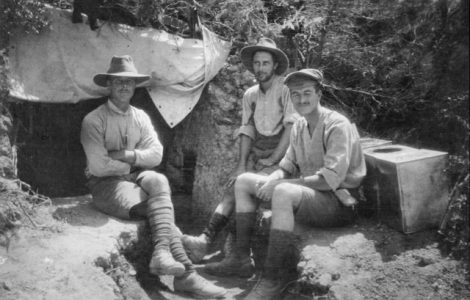

Crowd outside the Adelaide Club 1913. Image courtesy State Library of South Australia, PRG-280-1-7-526
March, 1916
During March, six o’clock closing for hotels became compulsory. This caused some fiery exchanges, especially as clubs like the Adelaide Club were permitted to continue service of alcohol beyond this time, but of course, membership was restricted.
WAR NEWS
The War continued to dominate the newspapers, whether it was news from the front or news about the impact of the war at home. The Advertiser printed a number of stories about the training activities of the new recruits at Mitcham Camp (who became part of the 43rd Battalion, which would leave Australia in June). It also reported on how recruitment was impacting on sport. Football, it was noted, would not be played again until after the War. There was also an article about the importance of refining plastic surgery techniques, given the high number of horrific head and facial injuries being sustained by soldiers.
Bad news from Europe – the likely defeat of the French at Verdun and the civilian casualties from German Zeppelin strikes in England – also featured in the paper, as did the news that Australia had established a Flying Corps (Ross Smith, whose letters and diaries have formed part of this narrative would join the Flying Corps, and we will pick up his story again in a couple of months).
FROM THE SOLDIERS
From our correspondents overseas we learn more about the activities of Australian troops. James Churchill-Smith’s diary documents the continuing training and routine of army life. The highlight of his month was taking two photos of the Prince of Wales, who inspected the troops with General Birdwood on 22 March. This was the same day that Lou Avery noted that ‘there are big movements of Australian troops and suspect they are going to France.’ He was correct – I Anzac Corps under command of Birdwood, did indeed leave Egypt for the battlefields of Europe during March. Lou was recovering well from typhoid and was well enough to notice the ‘ladies of the harem’ who lived in the large house adjacent to the hospital.
Leo Terrell was still not enjoying life in the Naval Bridging Train and was doing all he could to be transferred, but the end of the month sees him no closer to his goal.
DEAD OR ALIVE?
In last month’s post we also began following the story of Lance Alderson, whose father had enlisted the assistance of the newly opened Red Cross Information Bureau. We can only imagine the emotional roller-coaster he faced: Mr Alderson had received news from his niece that her husband (also serving in the army) had seen Lance in an Egyptian hospital, but later in the month he was informed that his son was ‘unofficially believed died of wounds’. No doubt Alexandrine Seager’s poem about the ‘Men of Anzac’ would have struck a chord.
HEADLINES AT HOME
At home, there were fears about the spread of Infantile Paralysis (polio) and a diphtheria outbreak in Petersburg (now Peterborough) caused concern. Anti-German feeling remained strong: at the national level, women were urged not to purchase products from German companies, while locally members of the German Club on Flinders Street were banned from assembling there.
During March, the number of Australians ‘under arms’ reached 200,000. This was a much higher number than the government had committed when war broke out, but it was clear that more enlistments were needed and the issue of conscription remained a hot topic.











